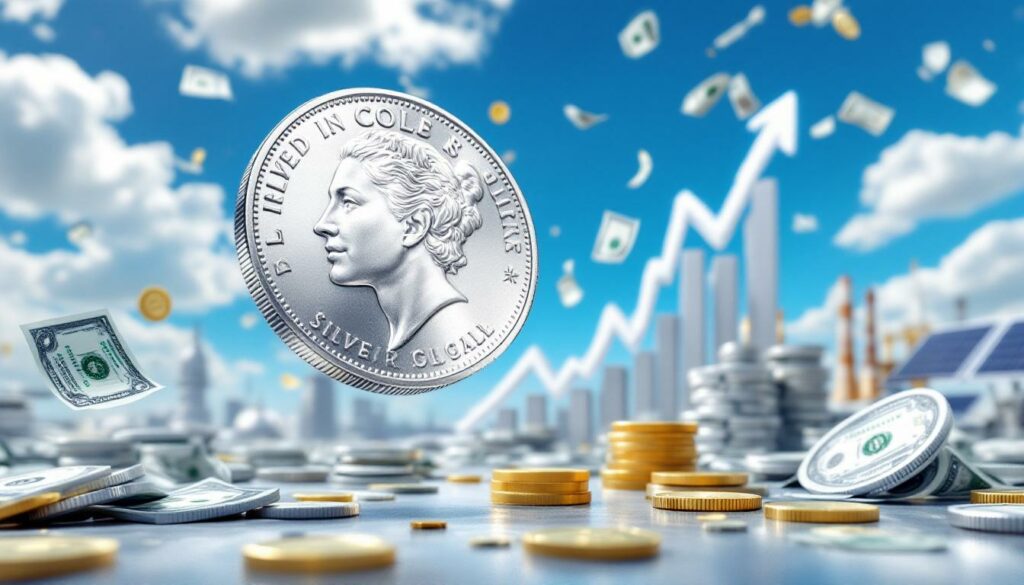What Factors Are Driving Silver Prices in 2025?
The Monetary Metal Advantage
Silver continues to demonstrate its status as a monetary metal rather than merely a precious metal. Unlike platinum, silver and gold serve as financial safe havens during economic uncertainty. This fundamental characteristic has been evident in silver's impressive performance, with prices surging from the upper $20s to the upper $30s in recent months while gold has remained relatively stable.
This divergence signals a significant shift in market dynamics that investors should closely monitor. As Michael Oliver of Oliver MSA explains, "Silver's recent outperformance relative to gold indicates we're entering a new phase of the precious metals bull market, where silver typically accelerates faster than gold."
Silver's classification as a monetary metal aligns it more closely with gold as a store of value, differentiating it from industrial precious metals that lack this safe-haven characteristic. This distinction becomes particularly important during periods of economic instability when historical silver trends provide valuable investment insights.
Global Economic Uncertainty
Several concerning economic indicators currently support higher silver prices. Consumer credit card debt has reached alarming levels, with delinquency rates climbing steadily throughout 2024. According to recent Federal Reserve data, credit card balances have surpassed $1.13 trillion, with late payments reaching the highest levels since 2011.
Tax filing delays have increased by 18% year-over-year, reflecting growing financial pressure on households. This trend serves as a reliable indicator of economic stress that historically correlates with precious metals appreciation.
Commercial real estate faces unprecedented challenges, with vacancy rates in major metropolitan areas exceeding 20% and property valuations declining by an average of 15-25% from peak levels. Unlike the 2008 crisis, today's debt pressures extend beyond mortgages to encompass government obligations, corporate financing needs, and commercial property valuations.
Government debt continues its exponential growth trajectory, with national debt increasing by approximately $1 trillion every 100 days – a pace that fundamentally undermines currency stability. These economic stress points collectively create an environment where monetary metals like silver typically thrive.
"When you see this constellation of debt pressures across multiple sectors simultaneously, history shows that monetary metals become the beneficiaries of capital seeking safety and preservation of purchasing power." – Michael Oliver
Central Bank Policies
Central bank responses to economic weakness remain a critical driver for silver price prediction. When analyzing historical patterns, we can observe that deteriorating economic conditions typically trigger aggressive monetary easing by central banks. The current environment, with weakening employment data and manufacturing metrics, suggests another round of significant intervention is likely.
Multiple Federal Reserve governors have already signaled support for interest rate cuts, with markets pricing in at least 75 basis points of reductions by year-end. This monetary policy direction traditionally benefits silver prices, as lower interest rates reduce the opportunity cost of holding non-yielding assets.
Importantly, precious metals typically begin advancing in anticipation of policy shifts rather than waiting for implementation, suggesting that current prices may already be factoring in expected monetary easing. The anticipatory nature of these markets means investors waiting for official policy changes often miss significant portions of the upward move.
How Has Silver Performed Compared to Other Assets?
Silver vs. Gold Performance
Silver has demonstrated remarkable strength compared to gold in recent months. While gold has experienced a consolidation phase, trading sideways for approximately four months between $2,300 and $2,450, silver has surged dramatically from $28 to nearly $40 – a gain of over 40%.
This outperformance represents a significant shift in market dynamics, as silver has historically lagged gold during earlier phases of the precious metals bull market. The gold-silver ratio insights reveal that the ratio has compressed from over 80:1 in 2023 to approximately 60:1 currently, reflecting silver's relative strength.
Historical analysis shows that during mature bull markets in precious metals, silver typically outperforms gold by a factor of 2-3x in percentage terms. The current acceleration appears to follow this pattern, suggesting we may be entering the more dynamic phase of the bull market where silver captures investor attention and capital flows.
Silver vs. Equity Markets
When comparing silver to equity markets over extended timeframes, silver's performance stands out dramatically. While major stock indices have delivered solid returns over the past 25 years, with the S&P 500 approximately tripling in value, gold has appreciated approximately 11-fold during the same period, with silver showing similar long-term strength.
This historical perspective highlights silver's potential as a wealth preservation vehicle during periods of currency devaluation. An investment of $10,000 in silver in 1999 would be worth approximately $110,000 today, significantly outpacing the same investment in broad market indices.
More recently, silver has outperformed the technology-heavy NASDAQ index over the past six months, gaining 45% compared to the NASDAQ's 12% increase. This relative strength during a period of strong equity performance demonstrates silver's current momentum.
Mining Stocks Performance
Silver mining stocks have shown particular strength recently, outpacing both the broader market and physical silver in percentage terms. The Global X Silver Miners ETF (SIL) has gained over 50% in the past six months, compared to silver's 45% increase, demonstrating the operational leverage inherent in mining equities.
This sector rotation suggests smart money may be positioning ahead of a more significant move in the underlying metal. The entire market capitalization of the VanEck Gold Miners ETF (GDX) represents approximately $15 billion – less than many individual technology companies – indicating significant room for capital inflows as institutional interest grows.
The relative value of mining stocks compared to physical silver has improved substantially, with several producers now trading at forward P/E ratios below 10 despite expanding profit margins. This valuation disconnect historically resolves through mining industry consolidation rather than metal price declines, suggesting potential for continued outperformance.
What Technical Indicators Support Higher Silver Prices?
Momentum Analysis
Momentum indicators for silver have turned decisively bullish after a multi-year consolidation phase. Using Oliver MSA's momentum structural analysis, which measures monthly price action against a 36-month moving average, silver's momentum structure shows a clear upward trajectory that began accelerating in early 2024.
This technical framework suggests the recent price action represents the beginning of a new acceleration phase rather than merely a temporary rally. Similar momentum patterns have preceded major advances in previous silver bull markets, including the 2009-2011 move from $12 to nearly $50.
The momentum oscillator's current reading of +15% above the long-term average indicates significant upward pressure without yet reaching overextended levels that would typically signal correction risk. Historical analysis suggests momentum readings can reach +40-50% above trend during peak acceleration phases.
Price Channel Breakout
Silver has recently broken above a well-defined parallel uptrend channel that had contained price action since the 2022 lows. This technical breakout is particularly significant as it occurred with strong volume and has been followed by consolidation above the previous channel resistance, now acting as support.
The breakout level at approximately $32 has been successfully retested, confirming its new role as support rather than resistance. This pattern completion satisfies classical technical analysis criteria for sustained upward momentum.
When measuring the height of the previous channel and projecting it from the breakout point, technical analysts derive price targets between $55 and $60 – aligning with other methodologies suggesting similar upside potential in the coming months.
Historical Price Structures
Silver is approaching critical historical resistance levels around $50, which represented major peaks in both 1980 and 2011. Technical analysis suggests that a decisive monthly close above this level would signal a major breakout from a decade-long base formation.
Previous instances of such breakouts in silver have led to explosive price movements due to the metal's relatively smaller market size compared to gold. When silver broke above its previous all-time high in 2010, it subsequently doubled within 12 months.
The consolidation period since 2011 represents one of the longest bases in silver's modern trading history. Extended consolidation periods typically precede proportionally significant advances when they finally resolve to the upside.
What Price Targets Are Analysts Projecting for Silver?
Near-Term Price Projections
Based on technical analysis and momentum studies, silver appears positioned to challenge its previous all-time highs around $50 in the coming months. Many analysts project a move to the $60-70 range before year-end, representing a significant advance from current levels.
Michael Oliver's technical analysis specifically projects silver reaching the $60-70 range within approximately five months, based on momentum analysis, channel breakout measurements, and historical precedent for silver's behavior during precious metals bull markets.
These near-term projections are supported by silver's recent technical breakout and relative strength compared to gold. The metal's behavior at the psychologically important $50 level will likely determine the pace and magnitude of the subsequent advance.
Long-Term Price Potential
When adjusting for inflation and currency devaluation since previous price peaks, silver would need to reach approximately $200 per ounce to match its 1980 high in real purchasing power terms. While this represents a substantial increase from current levels, the ongoing debasement of fiat currencies provides fundamental support for such long-term projections.
Historical analysis demonstrates that M2 money supply has nearly doubled every decade, far outpacing population growth or economic expansion. This monetary expansion creates structural pressure for higher nominal prices across asset categories, particularly those that serve as stores of value.
Silver's industrial applications in emerging technologies provide additional fundamental support beyond monetary demand. The metal's critical role in solar panels, electronics, and medical applications ensures baseline demand regardless of investment flows, potentially enhancing long-term price stability.
Mining Stock Implications
Analysts project that silver mining stocks could potentially triple in value relative to the metal itself over the next 12-24 months. This forecast is based on improving profit margins at current silver prices and the historical tendency for mining equities to deliver leveraged performance during strong bull markets in the underlying metals.
At current silver prices near $38, many producers generate cash flow margins exceeding 40%, compared to 15-20% margins when silver traded in the low $20s. This operational leverage typically results in accelerating earnings growth that supports higher equity valuations.
The mining sector's relatively small market capitalization means that modest capital inflows from broader markets could have outsized impact on valuations. If silver reaches the projected $60-70 range, many producers would generate record profits, potentially attracting institutional investors currently underexposed to the sector.
How Does Silver Compare to Traditional Safe Havens?
Silver vs. Government Bonds
Traditional safe-haven assets like government bonds have struggled despite economic uncertainty. Long-term Treasury bonds remain near multi-year lows in price terms (high yields), failing to respond positively even during equity market corrections.
The 10-year Treasury yield has remained elevated above 4% despite Federal Reserve signaling future rate cuts, indicating structural pressures in debt markets. This unusual dynamic has redirected safety-seeking capital toward monetary metals like silver, enhancing its appeal as a portfolio diversifier.
Unlike bonds, which face principal risk in rising rate environments, silver has historically performed well during both deflationary pressures (safe haven demand) and inflationary periods (currency debasement hedge), making it a more versatile portfolio component in uncertain economic conditions.
Silver vs. Cash Positions
With inflation eroding purchasing power and many banks offering inadequate interest rates, cash positions continue to lose real value over time. Even with the highest money market rates in 15 years, most cash instruments provide returns below the actual inflation rate experienced by households.
Silver provides an alternative that has historically preserved purchasing power during periods of currency devaluation, making it increasingly attractive as a cash alternative in the current environment. The metal's global recognition and liquidity offer advantages over other alternative assets that might serve similar portfolio functions.
For long-term wealth preservation strategies, particularly in environments of currency debasement and fiscal expansion, silver's historical performance during inflationary periods supports its inclusion in portfolios designed to maintain purchasing power over extended timeframes.
Silver's Industrial Demand Component
Unlike gold, silver benefits from substantial industrial demand in addition to its monetary properties. Approximately 50% of annual silver consumption comes from industrial applications, providing fundamental support beyond investment demand.
The metal's critical role in electronics, solar panels, and emerging technologies creates baseline demand that remains relatively stable regardless of financial market conditions. Solar panel manufacturing alone accounts for approximately 10% of global silver demand, with installations expanding globally as countries pursue renewable energy targets.
This dual-demand structure differentiates silver from purely monetary assets and potentially enhances its long-term price stability. While industrial demand may temporarily decline during economic contractions, it typically rebounds strongly during recovery phases, complementing investment demand that often surges during economic uncertainty.
What Risks Could Impact Silver Price Predictions?
Potential Market Corrections
Despite the bullish outlook, investors should remain aware that silver markets can experience significant volatility. Historical bull markets have included sharp corrections of 20% or more before resuming their upward trajectory.
The psychological resistance at $50 represents a significant technical hurdle that could temporarily slow silver's advance. Previous attempts to break through this level have been met with substantial selling pressure, as holders from previous peaks may choose to realize gains.
Proper position sizing and risk management remain essential when investing in this sector. Professionals recommend limiting precious metals exposure to levels that allow investors to maintain positions through inevitable volatility periods, typically suggesting 5-15% of total portfolio allocation depending on risk tolerance and investment objectives.
Economic Policy Shifts
Changes in monetary or fiscal policy could temporarily impact silver prices. A shift toward genuine monetary tightening (as opposed to merely slowing the pace of easing) could create headwinds for precious metals.
However, given the current debt levels and economic fragility, sustained restrictive policies appear increasingly unlikely. With government debt increasing by approximately $1 trillion every 100 days, the practical ability to maintain high interest rates faces structural constraints regardless of central bank intentions.
If economic data strengthens unexpectedly, the anticipated timeline for monetary easing might extend, potentially delaying but not eliminating the projected advance in precious metals prices. This scenario would likely create a buying opportunity rather than altering the long-term trajectory.
Technical Resistance Levels
The $50 level represents both psychological and technical resistance that could temporarily slow silver's advance. Market participants remember previous failed attempts to sustain prices above this threshold, potentially creating self-fulfilling selling pressure as the level approaches.
However, analysts note that the current fundamental backdrop is significantly more supportive than during previous approaches to this resistance zone. The combination of deteriorating economic conditions, anticipated monetary easing, and improved technical structure suggests greater potential for successful breakthrough than in previous cycles.
Short-term volatility may increase as silver approaches critical resistance levels, with profit-taking and technical selling creating temporary price pressures. These corrections, if they occur, may provide strategic entry opportunities for longer-term investors while testing the resolve of recent buyers.
How Are Silver Mining Stocks Positioned for Growth?
Improving Profit Margins
Silver mining companies are experiencing expanding profit margins as production costs remain relatively stable while metal prices increase. The average all-in sustaining cost (AISC) for primary silver producers ranges between $15-20 per ounce, compared to current silver prices near $38.
This cost structure creates substantial operating leverage, where each $1 increase in silver prices flows directly to the bottom line. For a producer with $18 AISC, the move from $25 silver to $38 silver represents a 160% increase in operating margin, from $7 to $20 per ounce.
These improving margins typically translate into accelerating earnings growth that supports higher equity valuations. Companies with fixed-price debt financing benefit particularly strongly in rising price environments, as revenue increases while debt service costs remain constant.
Sector Consolidation Opportunities
The silver mining sector remains relatively fragmented compared to gold, creating opportunities for consolidation and strategic acquisitions. Recent examples include Pan American Silver's acquisition of Yamana Gold's silver assets and Hecla Mining's purchase of ATAC Resources.
Companies with strong balance sheets may leverage current conditions to acquire promising assets, potentially enhancing shareholder value through expanded production profiles and resource bases. The improving economics of silver mining at current prices makes previously marginal projects economically viable, increasing the pool of attractive acquisition targets.
Merger and acquisition activity typically accelerates during bull markets in the underlying commodity, as improved cash flow provides acquisition currency while higher metal prices justify premium valuations for quality assets. This dynamic can create additional upside potential beyond the leverage to metal prices.
Production Growth Outlook
After years of underinvestment in exploration and development, silver mine supply has struggled to grow significantly. Global silver production has remained relatively flat at approximately 800 million ounces annually despite rising prices, indicating potential supply constraints.
This supply constraint, combined with increasing industrial and investment demand, creates favorable conditions for producers with existing operations and development-ready projects. Companies that maintained exploration and development activities during the previous downturn are particularly well-positioned to benefit from the current price environment.
Production expansion timelines in mining typically extend 3-5 years from discovery to production, creating a lag between price signals and supply response. This delay factor suggests that even if exploration investment increases substantially now, new production would not meaningfully impact market balances until after 2027-2028.
FAQ: Silver Price Predictions
Will silver outperform gold in 2025?
Based on recent market dynamics and precious metals analysis, silver appears positioned to outperform gold in percentage terms during the current phase of the precious metals bull market. This outperformance typically occurs during the later stages of major uptrends in monetary metals, as we're potentially witnessing now.
The gold-to-silver ratio has already compressed from over 80:1 to approximately 60:1, but remains above the long-term average of approximately 50:1. Historical precedent suggests this ratio could potentially reach 30:1
Want to Identify the Next Major Mineral Discovery?
Discover why significant ASX mineral discoveries can lead to substantial market returns by exploring Discovery Alert's dedicated discoveries page, featuring historic examples of exceptional investment outcomes powered by their proprietary Discovery IQ model.




